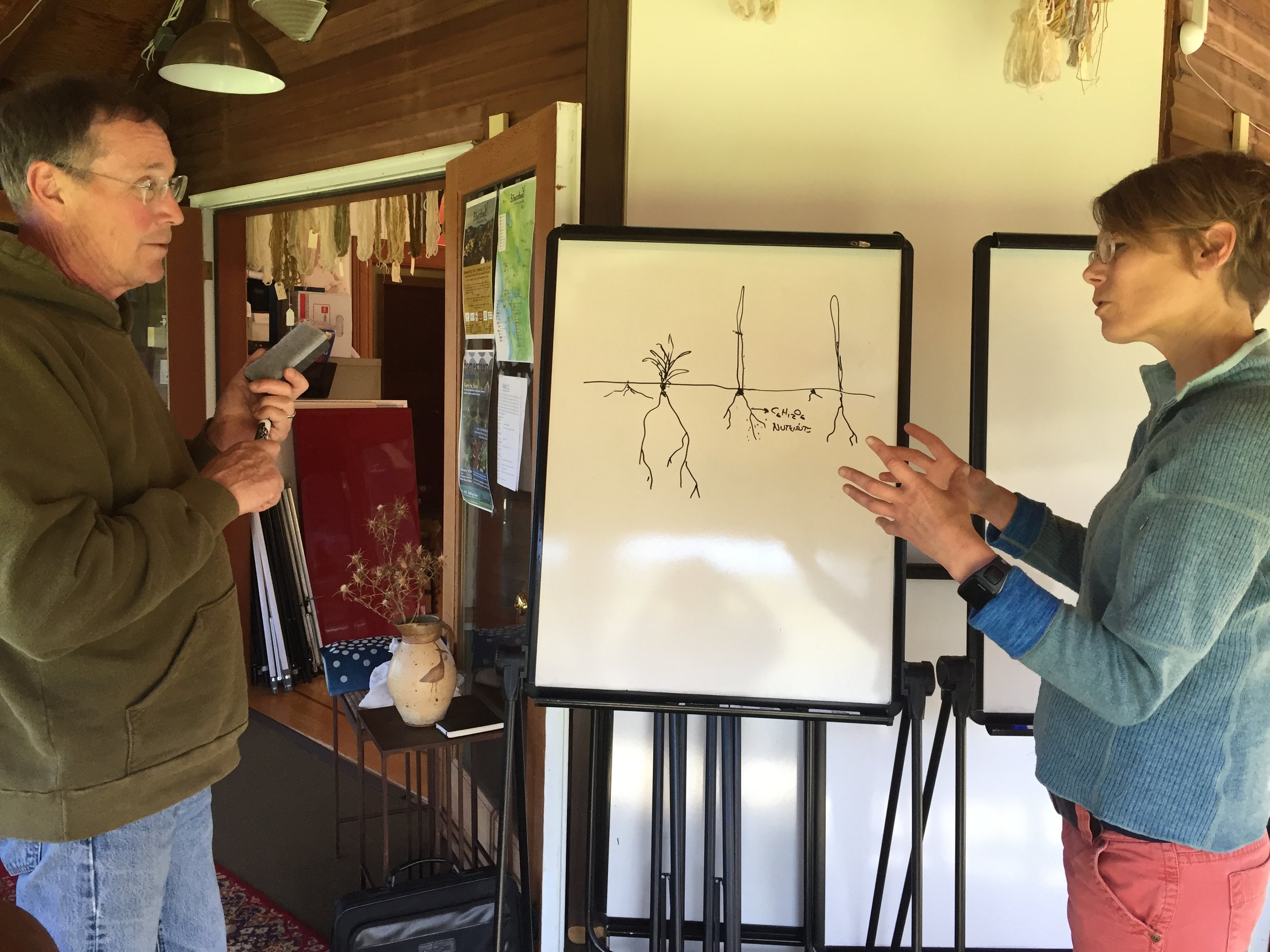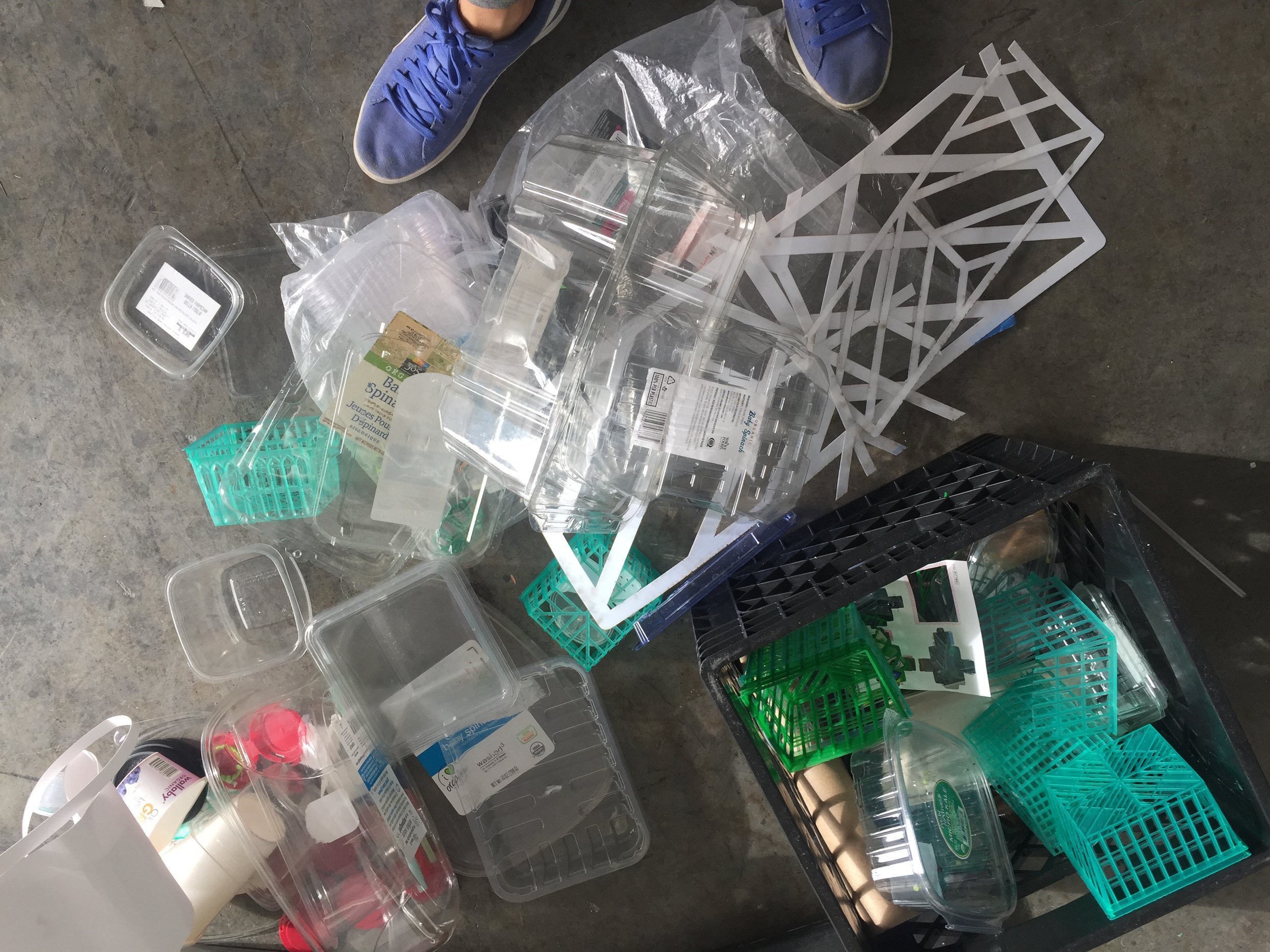Food, Landfill, Methane, Ink, acrylic paint, gouache, pencil, and soil on paper, 35 x 30 in., 2018
Black Gold: soil, compost, and the food waste cycle
During their year-long residency at San Francisco Recology (the city’s waste disposal service), Hughen/Starkweather investigated soil, compost, and the food waste cycle. When food is discarded into landfill it produces methane, a potent greenhouse gas. But as compost, food waste is converted into soil carbon, significantly contributing to carbon sequestration by storing carbon in the soil instead of releasing it into the atmosphere. The use of compost also greatly reduces the need for chemical fertilizers which enter freshwater systems.
The artists’ research included visiting local compost facilities and meeting with scientists and other specialists. Focusing on food waste, they collected discarded, single-use, plastic food packaging at the dump, and using ink and pencil, traced the shapes of the plastic food packaging onto paper to create repeated patterns, adding inks, paints, and collected soil rubbed into the surfaces. The resulting abstract artworks reference impacted landscapes and biochemical processes.
The series is titled Black Gold: a term commonly used for compost (referring to its dark color and high value), and a term also used for petroleum, a primary ingredient in plastic food packaging. The artworks were exhibited alongside source materials from the artists’ research including a library of books about compost and food waste, a slideshow of related information, and wall text that included information from scientists, specialists, and other data.
Can Dirt Save the Earth?, 39.5h x 40w in, Ink, pencil, gouache, and soil on paper, 2018
Like straws sipping carbon from the air, 16.75 x 12.5 in., Ink, acrylic paint, gouache, pencil, and soil on paper, 2018
“Creque had an answer for him. The carbohydrates that fattened the cows had come from the atmosphere, by way of the grass they ate. Grasses, he liked to say, were like straws sipping carbon from the air, bringing it back to earth. Creque’s quiet observation stuck with Wick and Rathmann. It clearly illustrated a concept that Creque had repeatedly tried to explain to them: Carbon, the building block of life, was constantly flowing from atmosphere to plants into animals and then back into the atmosphere. And it hinted at something that Wick and Rathmann had yet to consider: Plants could be deliberately used to pull carbon out of the sky.” Velasquez-Manoff, Moises, “Can Dirt Save the earth?” The New York Times, 18 April 2018
Creatures big and mobile enough to flee, Ink, acrylic paint, gouache, pencil, and soil on paper, on paper, 34 x 34 in., 2018
“Like a tornado spinning through a small town, the churning steel of the plow scrambles microbial communities, separating and disorganizing symbiotic partners, chasing out worms and other creatures big and mobile enough to flee.” Horn, Mirian, Rancher, Farmer, Fisherman: Conservation Heroes of the American Heartland, W.W. Norton Foundation, 2016
The other greenhouse gas, Ink, acrylic paint, gouache, pencil, and soil on paper, 35.75 x 46 in., 2018
Hughen/Starkweather scavenging at Recology, the San Francisco dump.
Hughen/Starkweather at the Recology compost facility in Vacaville, CA
Hughen/Starkweather with John Wick of the Marin Carbon Project.
Secret Superpower, 16 x 20 in., Ink, acrylic, compost, gouache, pencil and soil on paper, 2018
Breathing methane gas, Ink, acrylic paint, gouache, pencil, and soil on paper, 7.5 x 8.25 in., 2018
Airtight wraps, Ink, acrylic paint, gouache, pencil, and soil on pGampi paper, 12 x 11 in., 2018
“The disposable plastic products we use everyday can take over 400 years to biodegrade. The booming production of plastics in recent years, partly fueled by demand for single-use items such as coffee cups and bottled water, means the world has manufactured more plastic in the last decade than in the whole of the previous century.” Wright, Mike. “The stark truth about how long your plastic footprint will last on the planet,” The London Telegraph, 10 January 2018
Single-use plastic packaging scavenged from the dump.
Hughen/Starkweather at agricultural compost yards in Marin County, CA
“Once food reaches the landfills, the scraps begin to decompose, releasing methane gas into the atmosphere. Methane gas has a warming potential of roughly 21 times that of carbon dioxide, meaning it has an even larger impact on the global climate than CO2.” Anna Martin, Nicholas School of the Environment, Duke University












